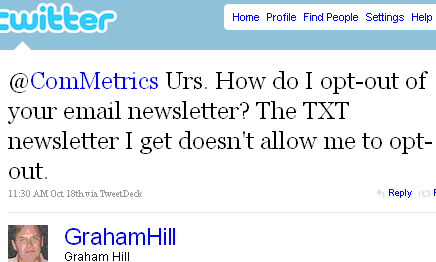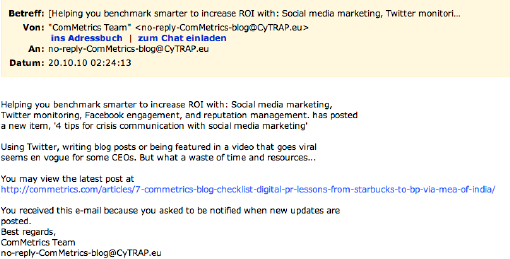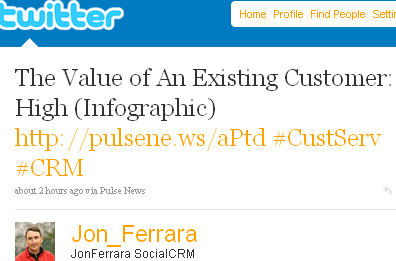Social media monitoring DOs and DON’Ts: social media marketing, social media metrics, social media monitoring tools, benchmark test, Twitter monitoring, luxury branding, and other happenings we came across while surfing the internet, blogging and posting on Facebook, Identi.ca, Google Buzz, or Twitter.
In this post, we share some interesting things we learned about customer relationship management, trust and possible failures.
- Wednesday
 Graham Hill sent us a tweet asking how to unsubscribe from our newsletter. Since we generally try to include an unsubscribe link in our communiqués, I asked Graham to send me a screenshot.
Graham Hill sent us a tweet asking how to unsubscribe from our newsletter. Since we generally try to include an unsubscribe link in our communiqués, I asked Graham to send me a screenshot.
It shows an email alert we send people who have subscribed to our weblog.

While people can easily unsubscribe by going to the blog itself (see right column of the website), we did not offer an easy option to do so in the alert itself.
This case illustrates how much it pays to listen, analyze the process and then engineer a solution whenever a subscriber or client points out an issue. The result is a better customer experience.
Don’t miss our next post! Provide your email and get it delivered to your inbox first; you’ll be glad you did.
- Thursday – why don’t we bother to check the source?
 The above case allowed us to investigate the cause, re-engineer the process and offer a solution, but we learned a lot more this week as far as trust is concerned.
The above case allowed us to investigate the cause, re-engineer the process and offer a solution, but we learned a lot more this week as far as trust is concerned.
These days, people are busy and hard-pressed to keep up with their social networks.
2010-10-20 – I came across a tweet by Jon Ferrara that certainly piqued my interest, so I clicked on the link he provided and ended up here:
But ReadWrite Start was not the original source of this information and referred to another blog post:
At the bottom of its graphics, Flowtown refers the reader to where the information came from. Unfortunately, no hyperlink is given, but I found the source:
By this time, I was completely unshocked to discover that Small Business Marketing Strategies’ 2009 blogpost was not the original source either, though it states:
- “The cost of customer acquisition versus customer retention could reach as high as 700 [percent], according to a report by Frederick Reichheld of Bain & Company.”
We could not find the report quoting the 700 or any other percentage anywhere (see the results I got on one search engine).
Nevertheless, some searching on Google reveals a short ‘white paper’ or executive summary that Small Business Marketing Strategies apparently used:
This refers to a book published in 2001. However, some sentences come word-for-word from a Harvard Business Review article I found:
- 1996-03-01 – Frederick F. Reichheld – Learning from customer defections (Harvard Business Review, free 22-page download or purchase a 14-page reprint)
As far as building trust is concerned, the above example indicates that neither ReadWeb Start nor the other blogs acknowledged, let alone mentioned, the original information source. Careful checking revealed that they also made some serious factual errors (e.g., that pesky 700 number).
Web 2.0 has resulted in an environment where too many people re-distribute news without first checking its veracity, in turn making it difficult to trust content providers.
Bottom line and take-aways
In short, it is all about analyzing social media failure while engineering its removal to acquire a road map to success. In this case, the following lessons can be learned from the above failures:
- 1. Listen to customer feedback, then fix the process: You must go to the trouble of engineering the removal of any faulty process. Retaining clients means improving their experience, which means we must listen to their concerns.
- 2. Check and re-check the resource to be sure: As students we always learned to check a reference in an article or book by looking up the original source to ensure correct citation (e.g., author name could have been misspelled). The same applies for social media; when you find something interesting, check for the original source and give your reader a link to it.
- 3. Trust is earned one person at a time: Make sure the facts, percentages and/or research findings are stated correctly in your material. If you fail to follow the above, at least you might make a fool of yourself. At worst, people may no longer trust your information… or you.
- Resources: The ComMetrics blog check => ComMetrics value check, LinkLove check and Trust check indices.
What is your take? How do you see these issues? Please let us know in the comments!
Article source: ComMetrics weekly review: Engineering failure-elimination
Quality and trust with social media content: 3 lessons in 3 minutes – The ComMetrics Intel Show.

Pingback: Askoli -rise with us
Pingback: JobShoots
Pingback: Chris Isaac
Pingback: CyTRAP
Pingback: Urs E. Gattiker
Pingback: CyTRAP
Pingback: Urs E. Gattiker
Pingback: pr-hamster
Pingback: CyTRAP
Pingback: Urs E. Gattiker
Pingback: MyComMetrics
Pingback: Alex Hall